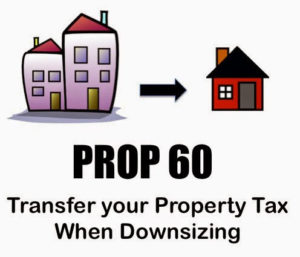Occasionally, when a law is passed not everybody is affected in the way the law intended. This is referred to as The Law of Unintended Consequences. When Proposition 13 passed in California in 1978 several significant and financially beneficial changes to the calculation of property taxes were implemented.
However, one change in particular took an unanticipated toll on older homeowners who were looking to trade down to a smaller home and that is the re-assessment of a property’s value when a change of ownership occurs.
As mandated by California’s Proposition 13, when a change of ownership occurs the value of the property is re-assessed and the assessed value becomes the sales price of that property, regardless of whether it was higher or lower than the property’s previously established assessed value.
 As older homeowners became empty nesters when their kids grew up and moved out they found themselves with more home than they needed. Many of those empty nesters owned their homes for a very long time and enjoyed the protections of Proposition 13 during that time, such as the 2% per year limit on the increase of their homes’ assessed value. As home values skyrocketed over the years they owned their homes they were protected from rampant and persistent increases in the amount of property taxes they owed.
As older homeowners became empty nesters when their kids grew up and moved out they found themselves with more home than they needed. Many of those empty nesters owned their homes for a very long time and enjoyed the protections of Proposition 13 during that time, such as the 2% per year limit on the increase of their homes’ assessed value. As home values skyrocketed over the years they owned their homes they were protected from rampant and persistent increases in the amount of property taxes they owed.
When those empty nesters sold their homes to purchase smaller homes they were shocked by the new property tax bill that came with their purchase.
Let me illustrate with an example. Let’s say you purchased a house 30 years ago for $100,000. With an effective property tax rate of 1.25% of the assessed value, your property tax obligation was $1,250 ($100,000 x 1.25%) per year. As a result of the 2% per year limit on the increase of the home’s assessed value mandated by Proposition 13, after 30 years the assessed value of your property would be $177,584 and your property tax obligation would have increased to $2,220 ($177,584 x 1.25%) per year.
Now let’s say you decided to sell your property, which is now worth $550,000, so you can purchase a smaller home more suitable to your current lifestyle and the purchase price is $400,000. Because Proposition 13 requires a property’s value to be re-assessed whenever a change of ownership occurs, your new property tax obligation would be $5,000 ($400,000 x 1.25%) per year. If the increased property tax burden doesn’t prevent you from being able to afford your new home altogether, the odds are that the property taxes will put a significant strain on your monthly cash flow.
To address this problem, in 1986, California voters passed Proposition 60, which allows a homeowner that is at least 55 years of age to transfer the base property tax value from the house he or she is selling (original property) to the house he or she is buying (replacement property), as long as the homeowner meets the following criteria:
- You, or a spouse residing with you, must be at least 55 years of age when the original property is sold
- The property you are selling and the property you are purchasing must be in the same county1 (i.e., San Diego property to San Diego property)
- You can only use the base property tax value transfer once your lifetime2
- Your replacement property must be of equal or lesser value than the sale price of your original property (i.e., $550,000) on the date of sale3
- Your replacement property must be built or purchased within 2 years (before or after) selling your original property
- Your original property must be your primary residence and have been eligible for the homeowners’ exemption or a disabled veterans’ exemption
- Your replacement property must be your primary residence and must be eligible for the homeowners’ exemption or disabled veterans’ exemption
 While this is great news for seniors, the closer I get to 55 years of age the more resistant I am to hearing 55 referred to as senior. I much prefer being referred to as señor.
While this is great news for seniors, the closer I get to 55 years of age the more resistant I am to hearing 55 referred to as senior. I much prefer being referred to as señor.
If the market value of your replacement property exceeds the market value of your original property as determined by the assessor, you will not receive relief.
The transfer of an existing property tax rate does not happen automatically. The eligible homeowner must file for the transfer.
Wherever there is a rule exceptions to that rule are not far behind. Some of the more important exceptions are below.
1In 1988, California voters passed Proposition 90, which allows a relocating homeowner to transfer the base property tax value to other counties within California. However, it is at the discretion of each county to authorize such transfers. At the time of this post there are 10 participating counties: 1) Alameda, 2) El Dorado, 3) Los Angeles, 4) Orange, 5) Riverside, 6) San Bernardino, 7) San Diego, 8) San Mateo, 9) Santa Clara, and 10) Ventura. Since the counties are subject to change, we recommend contacting the county in which you wish to move to verify eligibility.
2This is a one-time only benefit. Once you have filed and received this tax relief neither you nor your spouse who resides with you can ever file again, even if your spouse dies or if the two of you divorce. However, there is a one-time exception via Proposition 110 which says if you received relief for age and subsequently became severely or permanently disabled and have to move because of the disability, you may exercise this relief a second time for disability. However, you cannot receive relief for disability and later receive relief for age.
3The meaning of equal or lesser value depends on when you purchase the replacement property: If the replacement property was purchased or newly constructed before the sale of the original property then the replacement property can be no more than 100% (i.e., $550,000) of the market value of the original property. If the replacement property was purchased or newly constructed within one year after the sale of the original property then the replacement property can be no more than 105% (i.e., $577,500 ($550,000 x 1.05)) of the market value of the original property. If the replacement property was purchased or newly constructed more than one year but less than two years after the sale of the original property then the replacement property can be no more than 110% (i.e., $605,000 ($550,000 x 1.10)) of the market value of the original property.
As you can see, Proposition 60 and Proposition 90 may save California seniors a significant amount of property taxes if they choose to trade down to a smaller home, however there are many requirements and rules to adhere to. I have covered a majority of those requirements and rules, but for complete details see the California State Board of Equalization’s website.
Leave a Comment